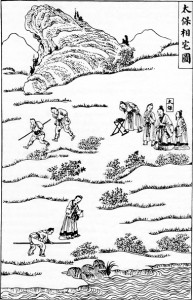The development of Feng Shui over the last 3,000 years has produced the simplified and esoteric New Age Feng Shui, influenced by the West, in addition to the Form School and the Compass School.
Origin

from Chinese Geomancy by Stephen Skinner p. 44 Fig. 2.
The origins can be traced back up to 3,000 years in writing. The term is first mentioned in the Book of Tombs (zang shu) ca. 5th century. v. Chr.
Clearer structures developed during the Qin (221-207 BC) and Han (207 BC – 265 AD) dynasties. The term bright hall (ming tang) was first used in the literature. The basic features of the form-power school (form school) connect the Qi with the forms in the landscape. In the 6th century. n. Feng Shui masters were already using the connections between the interactions between the 5 transformation phases. Until the end of the Tang Dynasty (618-907), theories such as the yin-yang school, the 5 phases of transformation, the form-force school and the structural qi school (compass school) were used.
Until the end of the Song dynasty (960-1279), ideas from Buddhism, Confucianism and Daoism were incorporated. The Compass School emerged as a supplement to the Form School. During this period, Chinese culture (philosophy and science) reached a peak. Gunpowder and the compass were developed during this time. China sent expeditions with large ships as far as Africa. Neo-Confucianism experienced its heyday. Yin-Yang as a symbol of Tai Ji and the concept of structural Qi (compass school) were important insights. The Form School examines the visible world and the Compass School the invisible. The form school developed in China in the mountains and river valleys of Jiangxi province and the compass school in Fujian province in southern China. These concepts form the basis of the mountain and water kites.
During the Mongolian Yuan Dynasty (1271-1368), the lunar calendar was further developed. The foundations of the 2 (Yin-Yang) x 5 (transformation phases) x 12 (earth signs) of the 60-cycle of heavenly tribes and earth signs were developed, which is mainly used in Bazi Suanming. In the Ming dynasty (1368-1644), the rational view of feng shui was transformed into a spiritual one. The unity of body, mind and qi and thus life was postulated. The knowledge was summarized in the system of the 8 directions (ba zhai). Huge encyclopedias were created.
Feng Shui on the road to modernity
In the Qing Dynasty (1644-1912), the methods of flying stars (fei xing) and mysterious emptiness (xuang kong) developed, but unfortunately also charlatanism. The misuse of feng shui has led to a standstill over the last 200 years. The inability of the last emperors to recognize or solve problems ultimately led to communism. With Mao’s “Great Leap Forward” and the Cultural Revolution, the basic culture of Feng Shui, the cult of ancestors and graves, was destroyed. Feng Shui, on the other hand, “survived” in Taiwan, Hong Kong and in Chinese emigration areas. Feng Shui publications have only been appearing in China again since 1994.
Western culture has discovered Feng Shui, mixing it with geomancy and New Age culture on the one hand and simplifying Feng Shui rules on the other, e.g. to the 3-door Bagua doctrine (New Age Feng Shui). Only the future will tell how far Western culture is prepared to delve deep into the Chinese background of feng shui and achieve real mutual development.
Literature
- 2008 Kubny, Manfred Dr.: “Feng Shui: The Structure of the World” p.343, enu

